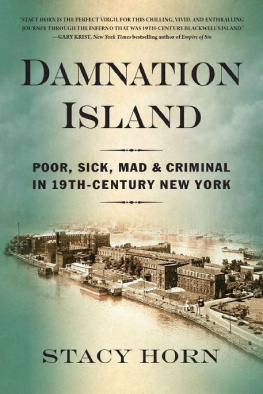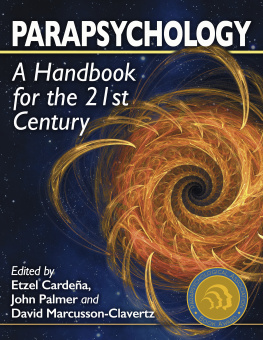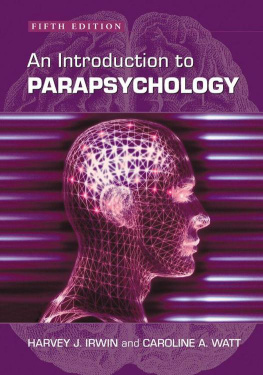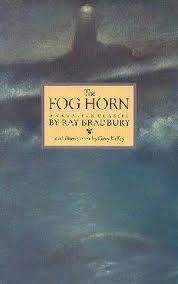What we are dealing with is a vast and half-lit area, where nothing seems believable but everything is possible.
Contents
Every ghost story begins with a love story, and usually
Before a small, unknown Methodist college was transformed into Duke
A few months later, on the other side of the
Stacks of letters from around the country began to arrive
We dont really know what we are. Written in 1944
A small bottle of water rises from a table. For
What they needed were new experiments, and Louie responded by
When something strange and frightening happens, people tend to call
On July 13, 1960, six-year-old Bruce Kremen became the fourth
It was the sixties now, but the Parapsychology Laboratory was
The same year that Rhine was taking peyote with Timothy
Just before Rhine retired from Duke in 1965, a seventy-five-year-old
It was the parapsychology critics themselves who finally convinced me
E very ghost story begins with a love story, and usually more than one. Once they are untangled, you will always find eternal love, unbearable loss, and unconquerable fear.
Everywhere, every minute, people all over the world are desperately begging God and any other power they can think of to not take someone they love, their child, their husband or wife, mother or father or friend. And finally, at the end, dont take me.
There is no spot on earth that is free from loss. On this street, or in this room, someone lay down or was put down and was no more. Someone held someone else for the last time here. Rivers and lakes and oceans are full of people who vanished beneath the surface and were never seen again. Wherever you are standing, wherever you call home, someone left the earth there. Everyone we love dies and disappears.
Something more substantial than a memory must survive of all that love. Its unthinkable that the dead are truly and completely gone. And if the dead are not completely gone, we, as every generation that came before, are compelled to look for whatever remains.
What is death but the end of all we love? Ghosts are what survive of love. Real or unreal, they are a testament to love, and the hope that no matter what, love lasts.
The men and women of the Duke Parapsychology Laboratory were scientists. They never would have phrased it this way. But when all is said and done, as they tried to prove that death is not the end, what they were really trying to prove is that love lasts forever. The problem was how to scientifically demonstrate that life and all the feelings that go with it survive death. A medium relaying messages of continuing love from a dead wife might be enough for an inconsolable widower, but it would never be enough for the scientific community, which demanded not only more convincing evidence but also experiments that could be reliably repeated to produce consistent results. To move an idea out of the realm of belief and into the world of accepted fact, others must be able to verify your results. There are no shortcuts to this process, and no exceptions. Like those we pray to when death is imminent, the scientific method is immune to longing, hope, and pleas.
Ive always been drawn to the dead and forgotten. My last book, about the New York Police Departments Cold Case Squad, had me immersed in unsolved murders for years. My plan was to find people who had been murdered and denied justice, and for whom it was over in every possible way. I was going to bring them back to life, if only on a paper stage. When the NYPD allowed me into warehouses and basements and closets to look inside hundreds of boxes of old homicide cases, many unopened for decades, I was practically hypnotized; it had the excitement of a treasure hunt and the hope of resurrection. The problem was that, while the research couldnt have been more fascinating, it was all ultimately heartbreaking. Everything I did came back to someone who had died, and always in some horrible and unthinkable way.
By the time I was done, I was ready to tell my agent that my next project would be a coffee-table book entitled Puppies of North America .
But then I thought: Whats more fun than a ghost story? Ive never been able to resist the paranormal. So I started looking for a story that was supernatural and scary and still sad, but without all the bloodshed. I began with a haunted house in New York City that Id heard about when I was a kid and had never forgotten. This led to a group of scientists at Duke University who specialized in parapsychology.
With few exceptions, scientists have always been disdainful of accounts of the paranormal and the idea of studying it rigorously. But there was a moment when science discovered a kaleidoscope of invisible forces, waves, and particles underneath a now thinner veil of reality, and that the universe is expanding. At that moment there was just enough give in the scientific community that phenomena that had always been dismissed as paranormal could be approached differently. In this brief window of opportunity, Duke University opened the Parapsychology Laboratory. Id heard of the lab over the years, but when I went down to North Carolina I had little idea of what went on there.
It was the Cold Case Squad all over again. There are over seven hundred boxes of lab archives at Duke University, and what I found inside was the story of scientists who were like paranormal detectives, but without the horrible murders, although in the end there were some of those, too. Like the cold case detectives who worked on homicide cases no one else could solve, the scientists at the Parapsychology Lab were looking at cases other scientists either didnt want to or couldnt explain. I was once again completely absorbed in material that few had looked at in decades. I found death and loss wrapped up in every box I opened, but this time, behind it all, was the hope of something more than a metaphorical resurrection.
The lab was headed up by a man named J. B. Rhine. Outside of parapsychology circles, Rhine is not well-remembered today, but in his time, he was the Einstein of the paranormal. Between 1930 and 1980 the media seized on Rhine and reported on nearly every bit of groundbreaking research that came out of the lab. From Life magazine to Readers Digest to the New York Times and the New Yorker , newspapers and magazines were eager to pass on any shred of evidence of life after death to a public that anticipated paranormal breakthroughs to rival those being heralded in other areas of science on what felt like an almost daily basis. In turn, the public would bring thousands of supernatural events to the labs attention. The scientists at the lab were flooded with mail and visitors, legendary and otherwise, including Albert Einstein, Upton Sinclair, B. F. Skinner, Richard Nixon, Aldous Huxley, Arthur Koestler, Carl Jung, Bill Wilson (the co-founder of Alcoholics Anonymous), and Jackie Gleason. Timothy Leary flew down to Duke in the sixties and got Rhine and some other scientists there to take their first psilocybin trip to see if this extraordinary drug could enhance the remarkable mental abilities they were trying to understandESP, psychokinesis, and clairvoyance. Helen Keller put her fingers to Rhines lips when they met and told him that she experienced ESP often. Rod Sterling, who really wanted to believe in the supernatural and ESP, kept an eye on their progress. The Army and the Navy gave the lab contracts to study extrasensory perception in animals, and the Air Force built an ESP machine, basically a simple computer that automated parts of the experiment. Defense industry contractors like General Dynamics stopped by at the request of the governments Advanced Research Projects Agency to see what the lab was up to. When word came from behind the Iron Curtain that the Russians had a parapsychology lab too, there was talk of a Manhattan Project for the paranormal. The CIA would eventually spend millions exploring mind control.









